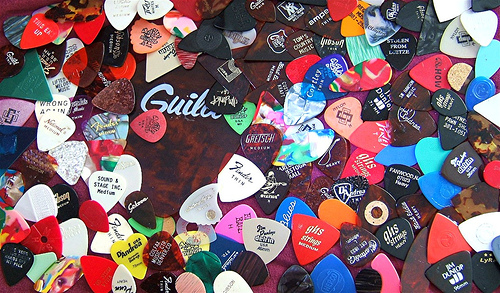If you’ve ever seen Tenacious D’s movie, “The Pick of Destiny”, then you know the great lengths a struggling musician would go to if it meant that their efforts would make them “the best in the world”. In the movie, the protagonists discover one commonality between every guitar hero who ever lived – they all used the same pick! Feeling that this pick is the secret to super-stardom, the two decide they need to have it. Thus begins an epic tale of two men who must battle through Rock and Roll Hall of Fame security, car chases in their friend’s pizza delivery car, and a crazed Tim Robbins wielding a tiny shiv. In the end, the heroes must face off against the devil himself as it is discovered that the pick is actually carved from his long lost tooth. In other words, it’s basically just the telling of any other day as the average musician. The struggle is real.
OK, maybe not that real. The idea that one guitar pick (Satan’s tooth or not) can turn you into a guitar god might be downright ludicrous, but the thought that your playing and tone can be improved by using a different pick isn’t so far-fetched.
Picture this if you will: you’re playing your guitar, and you’re unhappy with your tone. It’s not full enough! We’ve all been there, and chances are one of the first things to pop into your head was “Gee, I need a new guitar. Or an amp… or both”.
Now, new stuff is fun and all, but personally I’m all for not spending thousands of dollars (or fighting Satan) if I can fix a tonal problem for virtually zero cost. One such way would be by experimenting with different picks.
The three big factors you need to pay attention to when looking for the right pick to use would be it’s thickness, shape, and material. Using a super thin pick, for example, means that when you play, a lot of force is spent on the bending of the pick instead of the plucking of the string. Consequently, you get a much quieter and thinner tone. While the vibrational note of the string may be quieter, the percussive “picking” sound against the string is actually amplified as the thin pick slaps-back. For this reason, a thinner pick can be used if you’re looking for a softer, rhythmic strumming sound, almost as though a washboard is playing in the background.
On the other hand, if you’re looking for a more articulate, loud and full sound, you might want to look into trying out a thicker pick. Any style of playing where you need to be able to move quickly and freely between strings, tremolo pick, or hit loud and nasty chords would work better with a substantial pick in your hand. Just try some fast tremolo picking with a super floppy pick – it won’t really work. You need the pick to be able to glide through the strings, not get caught and flop around.

In addition to thickness, what the pick is made out of can impact your playing in a couple of ways. First, the attack and resonance of a string can be slightly altered by the pick’s material. For example, if you took a metal coin and plucked your strings, then did the same with a pick of the same thickness, you will notice a difference in sound. Picks have been made of all kinds of things.. plastic, metal, tortoise shell, even stone. That said, some are more common than others, and in stores, the three most likely you will see would be plastic, nylon, and “tortex”. You’ll really just have to experiment with different materials to find what you like. A thick plastic, rounded pick can work well for playing that requires a heavy attack and smooth articulation, while nylon might work well if you prefer a thinner pick. Personally, I’m a fan of “tortex”.

Back in the day, the material heralded as the absolute best for guitar picks was real tortoise-shell. I’ve never used one, but have heard time and again that the feel and sound from these is second-to-none. “Tortex” is a plastic material crafted by Dunlop to resemble real tortoise shell. While I can’t say from experience whether or not they successfully achieved this, I can say they successfully made my pick of choice! I think it’s something about their look and feel. Shiny plastic just looks and feels cheap to me, while these have some sort of grittiness to them that not only feels nice, but makes them easier to grip. As a matter of fact, I still have one of my first ones. Check it out! (on the right, of course.)
All in all, once again it’s just about experimentation. Using one guitar, try switching between a few different picks. You’ll be amazed at the difference in tone and feel.
Happy playing!



A pick is something often overlooked. I spent a lot of time trying different picks. Trying different picks helped me discover new ways to play old songs. I ended with the Dunlop Bug Stubby 3mm as my main pick for electric guitar. But when I play accoustic, I often like a very soft pick. I was give a pick punch years ago and used it to make picks out of different materials and thicknesses, I found the plastic from white milk containers made for some really nice thin picks. I have also experimented with metal picks and picks with odd shapes, each brought a different color to the sounds of the guitar and influenced my playing style.